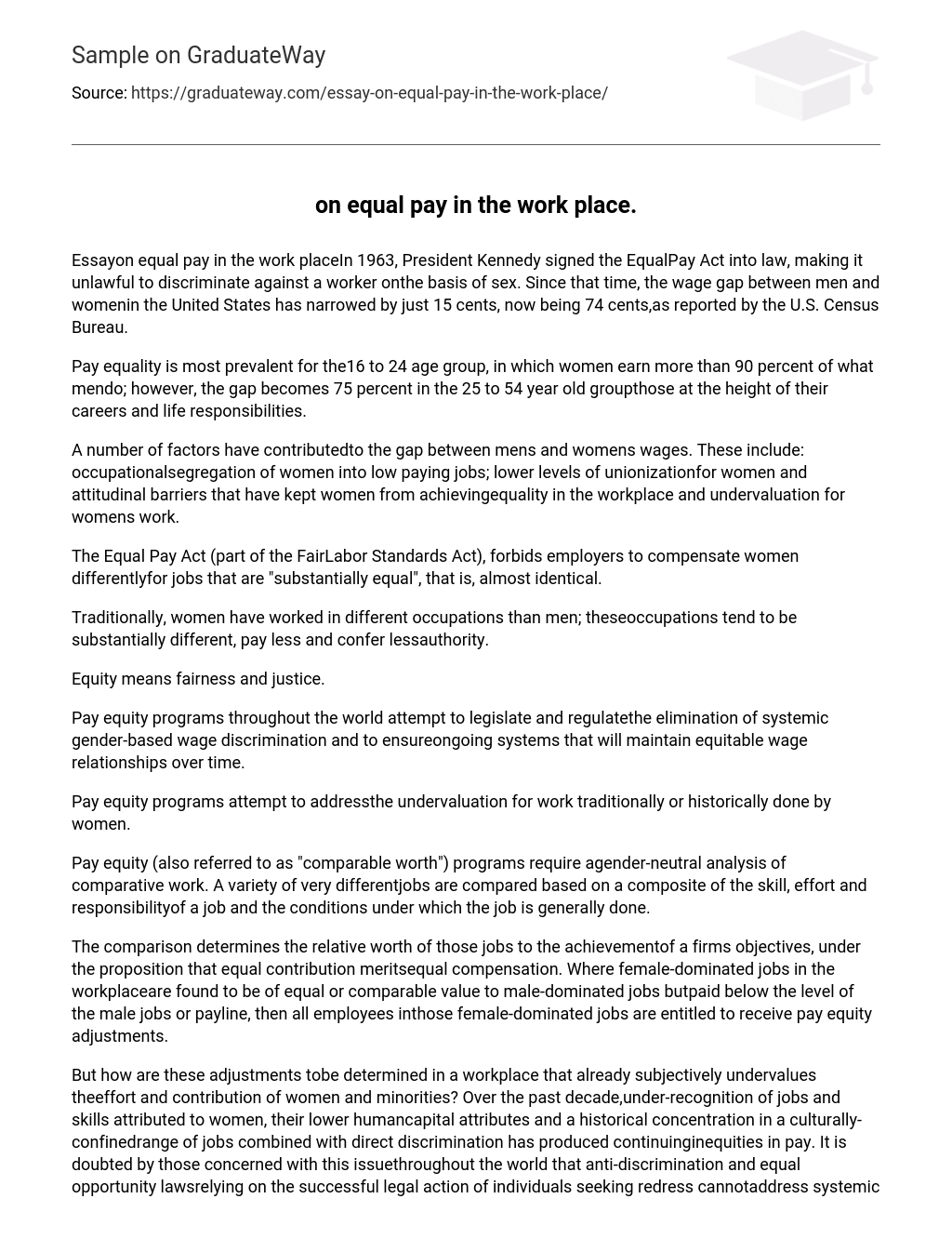Essayon equal pay in the work placeIn 1963, President Kennedy signed the EqualPay Act into law, making it unlawful to discriminate against a worker onthe basis of sex. Since that time, the wage gap between men and womenin the United States has narrowed by just 15 cents, now being 74 cents,as reported by the U.S. Census Bureau.
Pay equality is most prevalent for the16 to 24 age group, in which women earn more than 90 percent of what mendo; however, the gap becomes 75 percent in the 25 to 54 year old groupthose at the height of their careers and life responsibilities.
A number of factors have contributedto the gap between mens and womens wages. These include: occupationalsegregation of women into low paying jobs; lower levels of unionizationfor women and attitudinal barriers that have kept women from achievingequality in the workplace and undervaluation for womens work.
The Equal Pay Act (part of the FairLabor Standards Act), forbids employers to compensate women differentlyfor jobs that are “substantially equal”, that is, almost identical. Traditionally, women have worked in different occupations than men; theseoccupations tend to be substantially different, pay less and confer lessauthority.
Equity means fairness and justice:
- Pay equity programs throughout the world attempt to legislate and regulatethe elimination of systemic gender-based wage discrimination and to ensureongoing systems that will maintain equitable wage relationships over time.
- Pay equity programs attempt to addressthe undervaluation for work traditionally or historically done by women.
- Pay equity (also referred to as “comparable worth”) programs require agender-neutral analysis of comparative work. A variety of very differentjobs are compared based on a composite of the skill, effort and responsibilityof a job and the conditions under which the job is generally done.
The comparison determines the relative worth of those jobs to the achievementof a firms objectives, under the proposition that equal contribution meritsequal compensation. Where female-dominated jobs in the workplaceare found to be of equal or comparable value to male-dominated jobs butpaid below the level of the male jobs or payline, then all employees inthose female-dominated jobs are entitled to receive pay equity adjustments.
But how are these adjustments tobe determined in a workplace that already subjectively undervalues theeffort and contribution of women and minorities? Over the past decade,under-recognition of jobs and skills attributed to women, their lower humancapital attributes and a historical concentration in a culturally-confinedrange of jobs combined with direct discrimination has produced continuinginequities in pay. It is doubted by those concerned with this issuethroughout the world that anti-discrimination and equal opportunity lawsrelying on the successful legal action of individuals seeking redress cannotaddress systemic problems due to the undervaluation of feminized work.
Equality means equivalent, or equalin value, measures force, significance, etc. The idea of “equal payfor equal work” refers to men and women in the same job, under the samecircumstances, ability, seniority, performing equally well but being paiddifferently. Opponents of pay equity base theircriticism on economic theory; stating that the labor market establishesan employees worth. But Pincus and Shaw argue that this economicargument disregards the historical and cultural bases for the differential.
Many studies show that predominately female jobs pay less, on average,than predominantly male jobs. Debates over “comparable worth” policiescome from the findings that the sex composition of an occupation exertsa net effect on the wages earned, even after all other factors, which mayinfluence the outcome, are withdrawn. Studies done in North Carolinashowed that the higher percentage of female workers in an occupation hada negative impact on total pay.
Thomas R. Tudor points out in “TheComplex Issues of Pay Equity” (Journal of Compensation and Benefits, Jan-Feb1997 v12 n4 p.34) that what employers perceive as fair pay or even whatis legislated may not be perceived as such by current employees. Many employers attempt to achieve internal pay policies by standardizingpay ranges for a given position. Influencing factors may includefirm size, profitability, growth and market share; however, most companieswant to set compensation at whatever level they feel necessary to obtainthe highest efforts and results from their employees. Some of thesefactors can be subjective and lead, not only to defacto discrimination,but employee dissatisfaction in general, as they compare job responsibilitiesand relative productivity between the people on site.
Currently, in all methods of job evaluation,it is the requirements of the job itself that are evaluated, not individualperformance, and equity is not the goal.Advocates of pay equity want to legislatethat gender composition of jobs not affect the resultant pay. Systemscould be set up to establish rating scales on the basis of job evaluationswhere it is the requirements of the job and not the performance of a givenindividual within the job that are determinant factors in compensation.
This could include educational factors, how much time are spent on differenttasks and the sphere of responsibility incumbent upon the employee. Current plans most commonly use skill, effort responsibility and workingconditions as factors.
Critics of pay equity argue it could neverachieve its goal, and even if it did, it would have the undesirable sideeffects of the misemployment of women and hurt the economy of the enforcinggovernment. The fact is that pay disparity for men and women hasa serious effect on the economy, diminishing each womans purchasing powerin a society in which most marketing is done toward women, and also hasadverse effects on families with single mothers or other female head ofhousehold situations.
Critics also point out that women or minoritiescome to the market with productivity shortfalls. Conclusions of researchdone by Neumark in 1999 are that minority workers are paid lower startingwages, which are thought to reflect discriminations based on taste andlower expectations. Will the wage gap ever be solved for good?It is expected that with all the momentum from legislative efforts, individuallawsuits, and well-intentioned proponents, hopes are high that the paygap will be long gone by mid-century.





